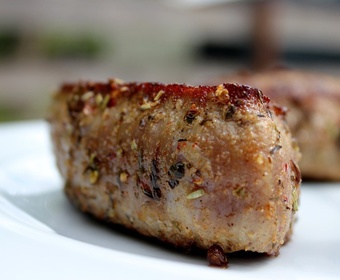
How to fry perfect pork chops
A pork chop provides a perfect portion of lean, nutritious meat. The downside is that there are not all that many ways to cook this particular cut, and that is why it is important that you apply every trick in the book when frying it:
1. The raw material is (almost) everything
Kitchen professionals will all tell you the same basic tip: Choose your raw materials with care. A pork chop is a cut that must be able to hold it’s own. You simply cannot cook an outstanding, juicy, tasty pork chop unless what you start out with is outstanding. You already knew this – but it’s easy to go wrong when you run into a good price, or when you’re hungry, or simply a little distracted.
How do you recognize a fine cut? You can find lots of tips under Choosing meat and More about pork. But above all: Talk to your knowledgeable butcher. Ask about breed, origin, feed, rearing, fat content, thickness, etc.
2. Take it out of the fridge
Pork is lean meat and that is why it is susceptible to contamination. But don’t be afraid to remove it from the fridge in advance – about an hour before – so that it is not cold when it goes into the pan. This way, you don’t risk frying the surface to a dry crisp while the core remains raw.
3. Fat equals taste
The more visible fat on your chops, the more taste you will be getting for your money. If the cut comes with fat on one side, maximize the deep, meaty flavors by keeping it on during frying. Let the guests remove the fat on the plate.
To avoid the shops turning into convex “cups” from the heat, make small cuts in the fat just before putting them in the pan.
4. Dry the meat
To get that perfectly browned surface that you have experienced when eating out, the surface of the meat must be perfectly dry before it goes in the pan. Otherwise the natural juices from the meat will cause the temperature in the pan to sink and the meat will boil, not sear. You don’t want that. Those tasty, toasted, toffee-like flavors on the surface are caused by something known as the Maillard effect. It only occurs if the temperature is above the boiling point. In other words, the water has to go.
A good idea is to store the pork chops over night in a way that lets air circulate, for example on a gridiron in the fridge. (The same goes for chicken when you want a nice and crispy skin.) Make sure the chops don’t come into contact with any other food.
5. Be generous with the salt
Pat a generous amount of salt into the dry meat – much of it will end up in the pan, not on your plate. Finely ground salt will penetrate faster than coarse varieties. Finish off with freshly ground pepper.
6. Thick/heavy and hot pan
The pan heats up the meat, but at the same time the meat also cools down the pan. That is why a heavier pan is better, and it should already be properly hot before you put anything in it.
The pork chops themselves will release water that has to evaporate fast so that the process of frying is “dry”. For that reason you mustn’t have too much meat in a small pan. If the pan is big and hot enough, you get the tasty Maillard effect when proteins and sugars on the surface of the meat become so hot that they react and form new aroma and flavor compounds.
7. The right fat
Frying the chops in butter is tricky, since high temperatures will cause it to burn. Use oil – or clarified butter. An effective technique is to baste the chops with the fat just before they go into the pan.
8. Finish off in oven
If you fry pork chops in a pan until they are done there is a big risk that the meat will be dry long before the heat has penetrated all the way in to the core. Do what the pros do (for a very good reason) and let the last phase of cooking the meat take place in a moderately hot oven, about 150°C should be enough.
9. Aim for 67°C
The recommendation is that pork chops and any meat from a pig should be heated to 70°C or more, but this high figure comes from a time when pork was risky meat. This is not the case anymore (and, scientifically speaking, the meat is safe already at 62,78°C).
Aim for an internal temperature of 67°C. This, in turn, means that you should remove the chops from the heat earlier, at about 62°C. Give them time to rest so that heat and juiciness is distributed evenly in the meat. The core is at its best, moist and delicious, if it has a pink shimmer.


